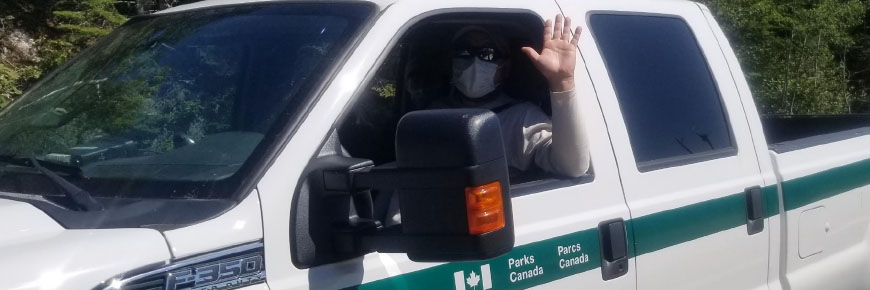
Management Plan Progress Report 2021-2022
Pukaskwa National Park
Download the PDF Version Here (English 10.3 MB)
Management plans identify the long-term strategic direction and vision for Parks Canada places. Plans provide a framework for site management, aligning with the Agency’s mandate, vision and strategic outcomes. Management plans are guiding documents for decision making and planning.
This annual update serves as a progress report to partners, stakeholders, and the public outlining our work in implementing the key strategies from the management plan over the last year.
Key Strategy 1: AN ENDURING RELATIONSHIP: Honouring the Anishinaabek and Métis, and their connection to the land known as Pukaskwa
- Continued working toward mutually beneficial purposes with Biigtigong Nishnaabeg through quarterly meetings of the Pukaskwa-Biigtigong Operational Working Group.
- Hosted 4 students from Biigtigong Nishnaabeg’s band office for summer placements; held virtual hiring sessions to support applicants on competitions; met virtually with Biigtigong Nishnaabeg band students to provide an overview of career opportunities with Parks Canada.
- Local First Nations continued to use the park for traditional activities like camping, fishing, medicinal harvesting and trapping throughout all four seasons.
- Collaborated with Biigtigong Nishnaabeg representatives on terrestrial archaeological surveys, ensuring artifacts were uncovered and collected in a culturally appropriate and respectful manor.
Key Strategy 2: A WILDERNESS SUSTAINED: Experiencing Pukaskwa’s wilderness through strengthened ecosystems
- Continued to implement the park’s Ecological Integrity Monitoring Program, exploring ways to collaborate with Biigtigong Nishnaabeg and incorporate Indigenous Knowledge in existing and new measures.
- Ensured that key ecosystem processes and species were maintained through the completion of 6 impact assessments on projects and work; daily surveillance and adaptive management actions were undertaken on 2 larger projects to protect ecological integrity.
- Kicked off year 1 of monitoring breeding birds to support the third Ontario Breeding Bird Atlas, a collaborative 5-year monitoring initiative led by Environment and Climate Change Canada and Birds Canada.
- Completed several species at risk Action Plan tasks, including the continuation of monitoring pitcher’s thistle colonies, acoustic monitoring of bats and wildlife camera monitoring of caribou habitat.
- Protected caribou habitat and backcountry visitors by supressing a lightning-started wildfire near the Coastal Hiking Trail, in collaboration with the province, so that the total area burnt was limited to 0.2 hectares.
Key Strategy 3: A “SUPERIOR” CONNECTION: Making Pukaskwa more relevant to Canadians
- Visitation increased 148% in 2021 (compared to 2010, the baseline year), once again exceeding the 10% goal set in the management plan, despite a shortened season due to the pandemic.
- oTENTik tents in Hattie Cove had an 82% occupancy, demonstrating continued high demand for this novel visitor offer in the fourth year of operations.
- Highlighted Pukaskwa in 11 stories for Shorelines Newsletter and 119 social media posts, positioning Pukaskwa as a destination of unsurpassed beauty and raising awareness of the park.
AREA Management Strategy: HATTIE COVE
- Revitalized Hattie Cove’s iconic wetland walkway by replacing the infrastructure with an entirely new walkway, connecting the Coastal Hiking Trail in a way that enhances visitor experience and safety, and improves ecological integrity for that area for generations to come.
- Provided online virtual orientations pre-arrival, to expedite visitor’s time at registration in Hattie Cove and maximize their time for backcountry discovery.
- Stabilized the shoreline for the marine operations base at the park administration offices, so that park staff can be assured access to the coastal area of the backcountry for operational needs for years to come.
AREA Management Strategy: LAKE SUPERIOR COAST
- Continued to invest in ecological integrity monitoring in the park through the collection of data and assessment of all monitoring measures for coastal ecosystems that were scheduled to be monitored this year.
- Backcountry visitation increased by 33% in 2021 compared to 2020, and represents the highest number of backcountry sites occupied in a single year.
- Visitors were engaged in Peregrine falcon monitoring, contributing records of sightings for the Ecological Integrity Monitoring Program.
- Date modified :